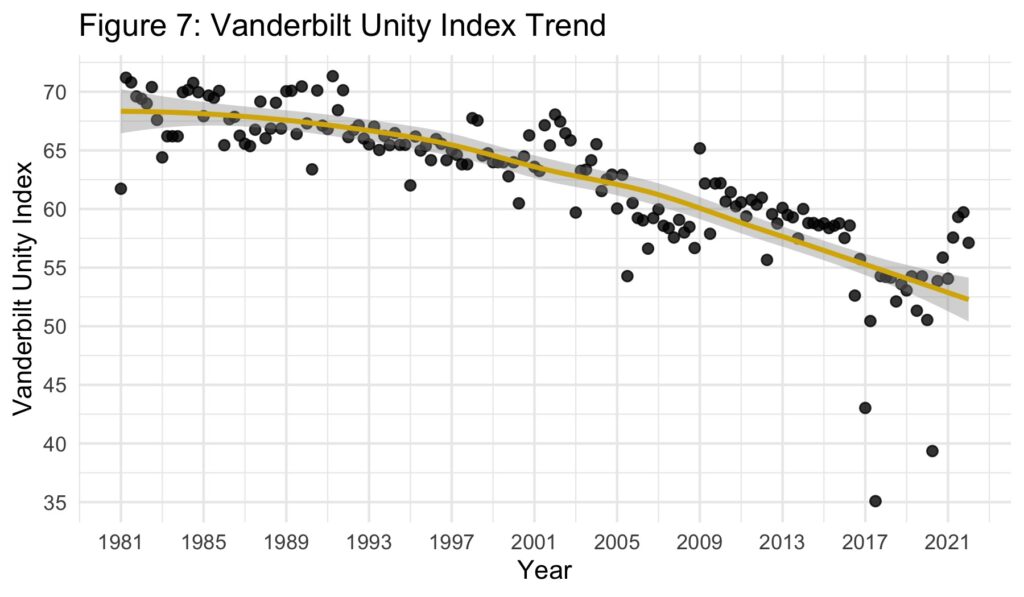Vanderbilt Project on Unity and American Democracy releases second quarterly Vanderbilt Unity Index data measuring Americans’ faith and trust in democracy
Americans’ general faith and trust in democracy has stabilized in the first half of 2022, remaining relatively flat through the second quarter, according to the most recent Vanderbilt Unity Index.
The index, which seeks to quantify unity by measuring fluctuations in Americans’ general faith and trust in their political institutions on a scale of 0-100, ticked slightly upward to 57.32 as of June 30, 2022, from 57.12 at the close of the previous calendar quarter.
“While these data do not fully reflect the potential fallout from the recent Supreme Court cases, including the landmark abortion ruling in Dobbs v. Jackson Women’s Health, these decisions, coupled with rising inflation and the ongoing Jan. 6 hearings, appear to have had minimal impact on Americans’ sense of unity. That may change, but at least at this point it is a positive sign,” said John Geer, the Ginny and Conner Searcy Dean of the College of Arts and Science at Vanderbilt University and one of the authors of the Vanderbilt Unity Index.
Of the five data points used to calculate the index, the most notable change this quarter was a four-percentage-point drop in ideological extremism; this data point usually shifts slightly less than two percentage points on a quarter-by-quarter basis. That decrease was largely offset by a three-percentage-point increase in strong presidential disapproval, a data point more vulnerable to short-term fluctuation. The remaining three data points—protests and civil unrest, congressional polarization and social trust—saw no change this quarter. (The latter two are only updated twice a year.)
According to Mary Catherine Sullivan, a doctoral candidate in political science at Vanderbilt University and one of the authors of the index, if this decrease in ideological extremism holds true in future quarters, it could indicate the reemergence of a more muscular middle in American politics. “The decrease in Americans identifying with extreme ideologies could have been influenced by the recent big political news and could indicate a shift from the ends of the political spectrum to the middle,” she said, noting that the next quarterly update to the index could indicate whether this thesis holds true.
The stabilization of the index for the first two quarters of 2022 demonstrates the broader rebound of this measurement of American political unity from its lowest points coinciding with President Trump’s time in office, Geer and Sullivan noted. For example, at the halfway point of 2020, the index was 18 points lower than it is today. This trend, especially if it continues, could demonstrate statistically the consequential role an American president’s rhetoric plays in shaping the populace’s overall faith and trust in democracy, the authors observed. Page Break
Vanderbilt Unity Index Background and Methodology
Launched by the Vanderbilt Project on Unity and American Democracy, the Vanderbilt Unity Index seeks to quantify shifts in American political unity on a quarterly basis by measuring fluctuations in Americans’ general faith and trust in their political institutions on a scale of 0-100.
To provide a historical basis against which to measure future readings, the index is composed of five components available to scholars since 1981:
- Strong presidential approval/disapproval ratings
- Surveys of ideological extremism
- Attitudes measured by the General Social Survey
- Congressional polarization, based on roll call votes
- Frequency of polling questions about protests and civil unrest
The index reached its high mark in the late summer of 1990 in the lead-up to the first Gulf War under President George H.W. Bush. From there, it follows a general downward trend, with nine of the 10 lowest-scoring quarters occurring between 2016 and 2020, a period corresponding generally with President Donald Trump’s time in office and marked by divisive political rhetoric.
Learn more at https://www.vanderbilt.edu/unity/vanderbilt-unity-index/
Graphs of Vanderbilt Unity Index Scores from 1981-2022

